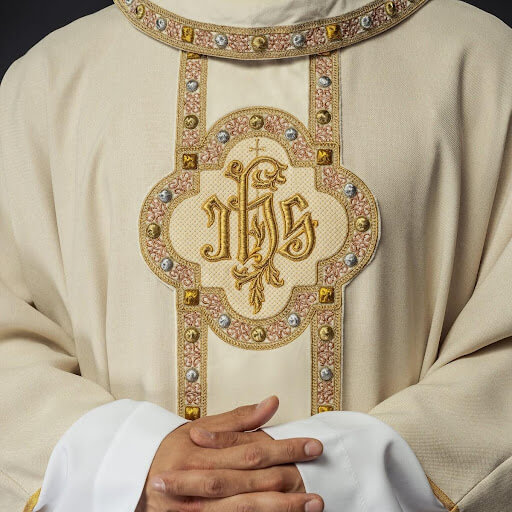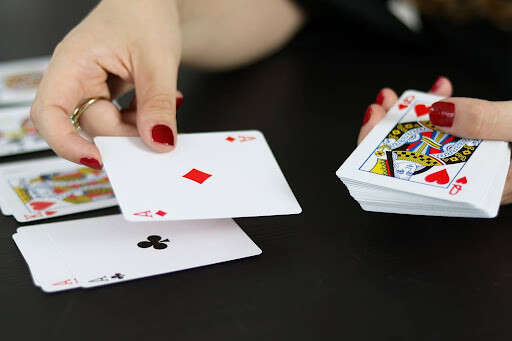Beaded embroidery is an exquisite technique that adds a touch of luxury and refinement to liturgical vestments. This art form, which combines artisanal precision and sparkling materials, creates sacred garments of extraordinary beauty. In the context of liturgical vestments, beaded embroidery is not only an aesthetic ornament but also a symbol of devotion and respect for the sacred.
The Art of Beaded Embroidery: A Centuries-Old Tradition
The origins of beaded embroidery date back to ancient times when beads were used to adorn clothing and valuable objects. Over the centuries, this technique has evolved, becoming a distinctive element of ceremonial and religious attire. Liturgical vestments, in particular, have benefited from the richness and brilliance that beads can confer. The use of beads in religious contexts often symbolizes divine light, purity, and spiritual transcendence.
Materials and Techniques: Creating a Precious Ornament
Beaded embroidery requires careful selection of materials and remarkable technical mastery. The beads used can vary in size, shape, color, and material, offering a wide range of creative possibilities. Among the most common materials are:
- Glass beads: appreciated for their brilliance and variety of colors.
- Crystal beads: offer superior shine and a luxurious appearance.
- Metal beads: add a touch of elegance and refinement.
- Stone beads: confer a more natural and earthy appearance.
The techniques of beaded embroidery vary depending on the design and the desired effect. Some of the most used techniques include:
- Stem stitch: for creating thin lines and delicate details.
- Satin stitch: for filling larger areas with a compact pattern of beads.
- Appliqué stitch: for applying pre-embroidered decorative elements with beads.
- Frame embroidery: for creating complex and structured designs.
The Symbolic Meaning of Beaded Embroidery in Liturgical Vestments
In addition to their aesthetic value, beads in liturgical vestments carry a profound symbolic meaning. The light reflected by the beads can represent the divine presence, illuminating the priest during the celebration of the sacraments. The colors of the beads can be chosen to correspond to the different liturgical seasons, adding a further level of symbolic meaning. For example, golden beads can symbolize the royalty of Christ, while blue beads can represent the Virgin Mary.
Examples of Beaded Embroidery in Liturgical Vestments
Beaded embroidery can be used in various ways to adorn liturgical vestments. Some examples include:
- Chasubles: beaded embroidery can be used to create complex patterns on the front and back of the chasuble, often depicting religious symbols such as the cross, the Lamb of God, or images of saints.
- Stoles: stoles can be embellished with bead embroidery along the edges or in the center, adding a touch of elegance and distinction.
- Mitres: mitres, worn by bishops, can be decorated with bead embroidery that reflects their authority and their role in the Church.
- Albs and surplices: bead details can be added to the collars, cuffs, or along the hem of albs and surplices, conferring a touch of refinement and solemnity.
- Humeral veils: beaded embroidery on humeral veils can create an extraordinary visual effect, especially when light strikes the beads, illuminating the priest who wears the veil.
HAFTINA TEXTILE GROUP SP. Z O. O.: Excellence in Beaded Embroidery for Liturgical Vestments
HAFTINA TEXTILE GROUP SP. Z O. O. is a leading company in the production and sale of liturgical vestments, renowned for its attention to detail, the quality of materials, and artisanal craftsmanship. Specializing in beaded embroidery, HAFTINAUSA.com offers a wide range of liturgical vestments embellished with this exquisite technique. The company stands out for its ability to combine tradition and innovation, creating sacred garments that reflect the beauty and sacredness of the liturgy.
HAFTINA TEXTILE GROUP SP. Z O. O. is committed to providing its customers with high-quality products, made with care and attention to detail. Each liturgical garment is a unique work of art, created to honor the celebration of the sacraments. The company also offers customization services, allowing customers to create tailored liturgical vestments that reflect their style and their devotion.
Choosing HAFTINA TEXTILE GROUP SP. Z O. O. means relying on a company with a long history of excellence in the field of liturgical vestments. The passion for detail, the quality of materials, and the artisanal craftsmanship are the pillars on which the company’s philosophy is based. Thanks to HAFTINAUSA.com, it is possible to enrich the liturgy with sacred vestments of extraordinary beauty and meaning.
How to Care for Liturgical Vestments Embroidered with Beads
To preserve the beauty and durability of liturgical vestments embroidered with beads, it is important to follow a few simple precautions:
- Gentle cleaning: avoid washing the vestments in the washing machine. It is advisable to dry clean or hand wash them, using a mild detergent.
- Proper storage: store the vestments in a cool, dry place, away from direct sunlight. Use padded hangers to prevent them from deforming.
- Protection from abrasions: avoid wearing the vestments in dusty or abrasive environments. Be careful not to bump the beads against hard surfaces.
- Timely repairs: in case of loose or damaged beads, repair the garment promptly to prevent further damage.
Conclusion: Beaded Embroidery, an Art to Honor the Sacred
Beaded embroidery on liturgical vestments is an art form that combines aesthetic beauty and symbolic meaning. This exquisite technique, which requires artisanal precision and precious materials, creates sacred garments of extraordinary elegance. HAFTINA TEXTILE GROUP SP. Z O. O. is committed to preserving this tradition, offering its customers high-quality beaded embroidered liturgical vestments, made with care and attention to detail. Choosing HAFTINAUSA.com means honoring the sacredness of the liturgy with vestments of timeless beauty.





















